QB5 - Question Bank 5 PDF

| Title | QB5 - Question Bank 5 |
|---|---|
| Course | Affärsutvecklingslabb |
| Institution | Kungliga Tekniska Högskolan |
| Pages | 104 |
| File Size | 3 MB |
| File Type | |
| Total Downloads | 33 |
| Total Views | 163 |
Summary
Question Bank 5...
Description
Fig 1 provides the variation of with I for various electrolytes. It is of interest to note that for non 1:1 electrolyte there exists a minimum value of and is indicative of ion association and reflects the failure of the Debye – Hückel limiting law
Fig 1: Schematic variation of the mean ionic activity coefficient on molarity of the electrolyte at 298K
Physical Significance of the Debye length The Debye length sometimes denoted as LD is
1
D
in the above notation and it
plays a central role in condensed matter physics. The Debye length represents the characteristic length within which the influence of the electric field is felt ie. beyond LD, the electric field does not have any effect on the ionic distributions.
Flow Chart for the Debye – Hückel theory of electrolyte solutions
Distribution of ions in a solvent
Computation of the mean electrostatic potential(r ) Electrostatics + Statistical mechanics Formulation of the Poisson equation Potential vs charge density Boltzmann distribution of ions Net number density Linearised Poisson – Boltzmann equation Solution of the differential equations Debye potential (r ) =
ze −D r e r
Excess thermodynamic properties Activity coefficient, Osmotic pressure Chemical potentials, Gibbs free energies
The Debye – Hückel theory pertains to the primitive model of the electrolyte since the solvent is treated as a continuum while ions are considered as point charges. The next improvement is provided by Restricted primitive model wherein the ions are treated as hard sphere, with the solvent being a dielectric continuum. There are other hierarchical improvements in this context such as Hypernetted Chain (HNC), Generalized Mean Spherical Approximation etc. The net result is that the Debye
1
length
D
is an involved function of the bulk concentration of the electrolyte as
well as ion sizes.
WORKED OUT EXAMPLES 1. Calculate the radius of the ionic atmosphere in aqueous NaCl solution of concentration 10-3 mol L-1 I= 1
D
1 ci zi2 = 10-3 2
=
3.035×10 -8 cm = 9.59 10-7 cm I
2. Use the Debye-Hückel limiting law to evaluate in 10-4 mol lit-1 of 2:2 electrolytes at 25 °C
1 I = ci zi2 = 1 10−4 4 10−4 4 = 4 10 -4 mol cm-3 2 2 log10 = −0.51 z+ z−
I
log = −0.51 4 4 10−4
and = 0.91
3. Calculate the Debye length for 8.25 10-5 mol kg-1 solution of Al2(SO4)3. I=
1 c i z i2 2
=
1 2 2 2 8.25 10−5 ( 3) + 3 8.25 10−5 ( 2) 2
=
8.25 10 − 5 18 + 12 = 15 8.25 10−5 mol kg m−1 2
= 1.2375 10-3 mol kg m-1 = 1.2375 mol m-3 D2 =
e 2 2I 0 kT
=
1.602 10-38 2 (1.2375 10-3 ) 6.023 1023 78 8.85 10−12 4.14 10−21
=
1.602 2 1.2375 6.023 78 8.85 4.14
κD2= 1.335 1019 met-2 1/κD = 2.736 10-10 met
4.
( )
A 50% v v
aqueous ethanol (dielectric constant =68) contains 0.001 mol kg-1
each in HBr and CaBr2. Find the mean activity coefficient ( ) of CaBr2 in this solution at 300K using the Debye - Hückel limiting law. Debye - Hückel limiting law is log10 = − A z+ z−
I
where A = 1.823 x 106 ( T)3/2 when = 68, A= 1.823 x 106
at T = 300K
(68 x 300)3/2 or A= 1.823 x 106
= 0.6256
2.914x 106 I=
1 1 mi zi2 = 0.001.12 + 0.001.12 + 0.001.22 + 0.002.12 2 2 1 2
or I = 0.001 + 0.001 + 0.004 + 0.002 = 0.004 log10 = −0.6256 2 1 (0.004)1/ 2 = − 0.6256 2 0.06324
or log10 = -0.07913 = 0.8334 5.
Calculate the Debye length of the ionic atmosphere for 0.012 N LaCl3 in nitrobenzene (dielectric constant = 34.8) at 300 K. Debye length,
1
D
1/2
− 10
= 2.81 10
T 2 ci z i
where ‘ ’ is the dielectric constant and ci is the concentration of the electrolyte in mL-1. For LaCl3, c=0.012N = 0.004 M = 34.8 and T = 300K
c z = (c 2
+
La 3
i i
2 2 .zLa 3+ + c − z − Cl Cl
)
= 4 x 10-3. 32 + 3 x 4 x 10-3.12 =36 x 10-3 + 12 x 10-3 = 48 x 10-3 = 0.048
34.8 300 = 2.81 x 10− 10 x −2 D 4.8 10 1
34.8 3 = 2.81 10− 10 10 2 4.8 or
6.
1
D
1/2
1/2
= 13.1 Å
The solubility product of CdSO4 is 9.2 x 10-11 M2. Calculate the mean activity coefficient of the Cd and SO 2-4 ions in a solution containing 0.05 M each of KNO3 in KCl, compare the solubility of CdSO4 in water.
The ionic strength of the solution containing KNO 3 and KCl is I=
1 c iz 2i = 0.1M 2 i
log10γ = − A z+ z−
I = − 2 2 0.51 0.1 = − 0.645
Hence γ = 0.226 K sp is water = 9.2 x 10-11 M2. Hence the solubility is
s = K sp = 9.6 x 10-6 M If the solubility in the solution is s, K sp =s 2γ 2 9.2 10−11 = s 2 ( 0.226 )
2
solubility = 4.25 10−5 M Thus the solubility increases in the salt solution. EXERCISES 1. The ionic strength of 0.1 M lanthanum phosphate solution is -------------------
-------2. The time taken for the formation of ionic atmosphere in the case of 1.0 M
NaCl solution is nearly -------------------seconds. 3. Which of the following has the largest thickness of the ionic atmosphere?
(A)1.0 M KCl;(B) 0.1 M KCl;(C)0.01M KCl and (D)1.5 M KCl 4. Calculate (i) the activity of the electrolyte and (ii) the mean ionic activity, a
of ions in 0.01 molal solutions of (a) Lanthanum nitrate and (b) Indium
sulphate, using the Debye-Huckel limiting law for the mean ionic activity coefficients. 5. Write the equation for the osmotic pressure of 1:1 electrolytes of 0.0001 M
concentration under the Debye – Hückel approximation. 6. Use the Debye – Hückel limiting law to estimate in 10-6 M solution of
ZnSO4. 7. Write the expression for the mean electrostatic potential ( ψ ) at a central ion
on the basis of Debye–Hückel’s theory. 8. Calculate the Debye length for 0.001 M solution of 2: 2 electrolytes in
nitrobenzene at 25ºC. 9. Consider the ions of charges Zi and zj immersed in a solvent of dielectric
constant . The diameters are i and
j
respectively. Write the expression
for the pairwise interaction u ij for this system. 10. What is the mean distance between ions when their number density is 1 x
1024 ions / cm3? SUMMARY The subtle features underlying the Debye–Hückel theory of electrolytes have been outlined. The limitations and merits of the Debye –Hückel theory they have been pointed out. Recent improvements of the Debye – Hückel theory have been indicated. Appendix A An important aspect wherein the SI and Gaussian units differ is the placement of the 4π’s in the governing equation. Units wherein the 4π’s have been eliminated
from Maxwell’s equations are rationalized units; SI units are an example of rationalized units, since the 4π’s do not appear. Gaussian units are not rationalized and hence ‘4 π’ appears. 1. 1 statvolt is (approximately) 300 Volts 2. The conversion from SI to Gaussian units can be accomplished by replacing 1/4πε o by
Thus Poisson’s equation in SI and Gaussion units are as follows. 2 = -
ρ (SI) εr
2 =-
4 εr
(Gaussian)
where ε r is the relative permittivity (or dielectric constant) given by ε/ε In SI units, 2 =
-ρ ε
In Gaussian units, we replace 4 by 1. Hence, 2 =-
4 ε
3. is the permittivity of vacuum. SUMMARY The assumptions underlying Debye Hückel theory are pointed out. Recent improvements pertaining to the theory of electrolyte solutions have been indicated.
Module II - Electrode potentials and Applications Learning objectives After reading this chapter, you will be able to (i) comprehend the importance of Nernst equation (ii) predict the occurrence of chemical reactions (iii) employ Latimer and Frost diagrams for disproportionation reactions Introduction The analytical and physicochemical applications of the Nernst equation are exhaustive and hence an outline of various applications is provided below. At a preliminary stage, it is essential to acquire expertise in writing the Nernst equations for various types of half cells. It is customary to write both the half-cell reactions as reduction and cancelling the number of electrons when the complete cell reaction is considered. The terminology of anodes and cathodes will be different depending upon whether one considers galvanic or electrolytic cells. The galvanic cells are energy storage devices since they convert chemical energy into electrical energy, e.g (batteries, fuel cells etc). The electrolytic cells on the other hand, involve supplying electrical energy in order to bring about a chemical transformation. The synthesis of organic and inorganic compounds, extraction of metals from their respective ores etc are carried out in electrolytic cells. Thus, it is now customary to consider oxidation as occurring at anodes and reduction as a cathodic process. This nomenclature will be valid irrespective of whether one employs galvanic or voltaic cells.
1
Table 1: Half-cell reactions and corresponding Nernst equations
Half Cell
Ag|AgCl| KCl
Reduction
AgCl + e-
𝐻𝑔|𝐻𝑔2 𝐶𝑙2 |𝐾𝐶𝑙
-
𝐻𝑔|𝐻𝑔2 𝑆𝑂4 |𝐾2 𝑆𝑂4 Hg2SO4 + 2e
Hg/HgO/NaOH 𝐴𝑔|𝐴𝑔2 𝑂|𝑁𝑎𝑂𝐻
Sb|Sb2O3|NaOH
= 𝐸0 − 0.059 𝑙𝑜𝑔 𝑎𝐶𝑙−
-
-
2Hg + 2Cl
𝐸 = 𝐸° −
2Hg +SO4
-
𝐸 = 𝐸0 −
Pb + 2SO4-
PbSO4 + 2e-
HgO + H 2 O + 2e-
Hg + 2OH -
Ag2O + H 2O + 2e-
Ag+ 2OH-
Sb2O3 + 3H2O + 6e-
2Sb+ 6OH-
𝑃𝑡|𝐻2 |𝐻𝐶𝑙
2𝐻+ + 2𝑒 − → 𝐻2
𝑃𝑡|𝐶𝑙2 |𝐻𝐶𝑙
𝐶𝑙2 + 2𝑒 − → 2𝐶𝑙−
𝑃𝑡|𝐹𝑒 3+, 𝐹𝑒 2+
2
𝐸
Ag + Cl-
Hg2Cl2 + 2e
𝑃𝑏|𝑃𝑏𝑆𝑂4 |𝐻2 𝑆𝑂4
Nernst Equation at 298K
Fe3+ + e -
Fe2+
𝐸
= 𝐸0 −
0.059 2
0.059 2
2 − 𝑙𝑜𝑔 𝑎𝐶𝑙
𝑎𝑆𝑂42−
0.059 𝑙𝑜𝑔 𝑎𝑆𝑂42− 2
𝐸= 𝐸 0 −
0.059 𝑎2𝑂𝐻 − 2 𝑎𝐻2𝑂
𝐸= 𝐸° − 0.059
𝐸= 𝐸 0 −
2 − 𝑎𝑂𝐻
𝑎𝐻2𝑂
0.059 𝑎6𝑂𝐻 − 6 𝑎𝐻32𝑂
𝐸 = 𝐸° −
0.059 𝑝𝐻2 2 2 𝑎𝐻 +
0.059 2 𝑎𝐶𝑙− 2 𝑎𝐹2+ 𝑒 𝐸 = 𝐸 0 − .059. 3+ 𝑎𝐹𝑒
𝐸=𝐸° −
𝐸
8
𝐶𝑑 − 𝐻𝑔|CdSO4. 𝐻2 𝑂 3
|CdSO4 (saturated)
𝑃𝑡|𝑄0𝑥 , 𝑄𝐻2 |𝐻𝐶𝑙
CdSO4 + 2e-
Cd2+ + 2SO 4-
= 𝐸° − 𝐸
Qox + 2H+ + 2e-
QH2
0.059 𝑎
= 𝐸0 −
2
2−
𝐶𝑑 2+ 𝑎𝑆𝑂4 𝑎𝐶𝑑2+
1 . 059 𝑙𝑜𝑔 𝑎𝐻 + 2 2
Sign Convention The IUPAC (or Stockholm) convention employs the reduction potentials of both half cells. The net cell emf is positive and hence the reaction is spontaneous. Consider the half-cell represented as Cd | Cd2+ and during the discharge of Cd 2+ , the Cd electrode acquires positive charge and hence the reduction potential is positive while ΔG is negative. Analogously, in a complete cell when both half cell reactions are written as reduction, the sign of the overall cell potential will correspond to that of the r h s in the cell representation. The potential is calculated as the difference between the rhs and lhs of the cell representation. The important points in the construction of electrochemical cells are as follows: 1.Both half-cell reactions should be written as reductions; E0(rhs)-E0(lhs) should be positive in the cell representation for any galvanic cells. 2. ΔG should be considered while manipulating cell reactions and not the electrode potentials. Thermodynamic considerations underlying Nernst equation Consider a general chemical equilibrium such as aA + bB + ...... = cC +dD+ ......(1) The Gibbs free energy change (ΔG) is given by ΔG = (c ΔG c+ d ΔG D+.....)- (a ΔG A+ b ΔG B+....)
------ (2)
Further, ΔG under standard conditions (ΔG0) becomes ΔG = (c ΔG 0C+ d ΔG 0D+.....)- (a ΔG 0A+ b ΔG 0A+....) ------ (3) where 𝜇𝐴 , µB … denote the respective chemical potentials. However, the chemical potentials are given by following general equations: 3
𝜇𝐴 = 𝜇𝐴0 + 𝑅𝑇 𝑙𝑛 𝑎𝐴 − − − (4)
𝜇𝐵 =𝜇𝐵0 + 𝑅𝑇 𝑙𝑛 𝑎𝐵 − − − (5)
𝜇𝐶 = 𝜇𝐶0 + 𝑅𝑇 𝑙𝑛 𝑎𝐶 − − − (6)
𝜇𝐷 = 0𝜇𝐷+ 𝑅𝑇 𝑙𝑛 𝑎𝐷 − − − −(7)
Hence 𝛥𝐺 − 𝛥𝐺 0 = 𝑅𝑇 𝑙𝑛
𝑎𝐶𝑐 𝑎𝐷𝑑 𝑎𝐴𝑎 𝑎𝐵𝑏
----(8)
At equilibrium ΔG = 0 Hence, one can write 𝛥𝐺 0 = −𝑅𝑇 𝑙𝑛
𝑎 𝐶𝑐1𝑒𝑞 𝑎𝑑𝐷1𝑒𝑞 𝑎𝐴𝑎 𝑒
1
𝑎𝑏 𝑞 𝐵1𝑒𝑞
− − − (9)
where the activities are now the values at equilibrium. Thus 𝛥𝐺 0 = − 𝑅𝑇 ln K 𝑒𝑞 ----- (10) Furthermore, employing 𝛥𝐺= −𝑛𝐹𝐸 and Δ𝐺 0 = −𝑛𝐹𝐸 0 , the familiar Nernst eqn follows as 𝐸 = 𝐸0 −
𝑅𝑇
𝑛𝐹
𝑙𝑛
𝑎𝐶𝑐 𝑎𝐷𝑑 𝑎𝑎𝐴 𝑎𝐵𝑏
-----(11)
Standard Chemical potentials For a reduction reaction such as Fe 3+ + e-
= Fe 2+, occurring at an inert electrode ( Phase
I) while the Phase II denotes an electrolyte, the equilibrium condition is given by
Fe , phaseII + e− , phase I = Fe , phase II 3+
II
2+
aFe3+ a 0 3+ Fe
0Fe + RT ln 3+
a 2+ 0 0 + nFII + I e− − FI = II Fe2 + + RT ln 0Fe a Fe2+
The Galvani Potential (vide infra) is given by
I − II = 0 + 4
0 RT aFe3 + aFe ln . 0 2+ F a Fe2 + a Fe3+
+ 2F II
where 𝛥𝜑 0 =
0 𝐼𝐼 𝜇 𝐹𝑒3+
− 𝐼𝐼𝜇
0 𝐹𝑒2+
𝐹
+ 𝐼𝐼 𝜇 𝑒−0
Formal potentials In general, the Nernst equation can be written in terms of the activities and hence 𝛾𝑖
𝑅𝑇 𝛱𝑎𝑖,𝑝 𝑙𝑛 𝐸 = 𝐸° − 𝛾𝑖− − − (12) 𝑛𝐹 ∏ 𝑎𝑖,𝑟
where
∏ refers to the multiplication symbol. A subtle distinction can be obtained by
replacing the activities with concentrations so as to obtain 𝐸=𝐸° ′ −
𝑅𝑇
𝑛𝐹
𝑙𝑛
𝐶𝐶𝑐𝐶𝐷𝑑
𝐶𝐴𝑎 𝐶𝐵𝑏
− − − −(13)
𝐸°′ is designated as the formal potential and is related to E0 as 𝐸°′ = 𝐸° −
𝛾 𝑐𝛾 𝑑 𝑅𝑇 𝑙𝑛 𝐶𝑎 𝐷𝑏-----𝑛𝐹 𝛾𝐴 𝛾𝐵
(14)
If all the activity coefficients are unity, the formal potential becomes identical to the standard electrode potential. The following Table provides a few formal potential values. The Nernst equation, taking into account, the activity coefficients, stoichiometric coefficients and the formal potentials can be derived in the following manner: Consider the reduction: 𝑣𝐴 + 𝑛𝑒 − = 𝑣𝐵 𝐵. The electrode potential E is given by 𝐸=𝐸° −
𝑅𝑇
𝑛𝐹
𝑙𝑛
𝜈
𝑎𝐵 𝐵
𝑣 𝑎𝐴 𝐴
= 𝐸° −
(𝐶 𝛾 ) 𝜈𝐵 𝑅𝑇 𝑙𝑛 (𝐶𝐵 𝐵 )𝑣𝐴 𝑛𝐹 𝐴 𝛾𝐴
𝐸°′ is referred to as the formal potential and is related to E0 as 𝐸°′
𝜈
𝑅𝑇 𝛾𝐵 𝐵 = 𝐸° − 𝑙𝑛 𝑛𝐹 𝛾𝐴𝑣𝐴
Hence the Nernst eqn is given by 𝜈
5
𝑅𝑇 𝑐𝐵𝐵 𝐸 = 𝐸°᾿ − 𝑙𝑛 𝑛𝐹 𝑐𝐴𝑣𝐴
The single ionic activity coefficients cannot be experimentally obtained; but can be theoretically estimated using various theories such as Debye-Hückel theory, scaled particle theory, hypernetted chain approximation etc. Table 2 : Formal electrode potentials at 25 ˚ C for a few compounds Compound
E(V vs. SHE)
Ru (NH3)5(py)2+
E˚’ = 0.299, 1M CF3 SO3H
Thionine
E˚’ = 0.056, pH =7
Ru(NH 3)63+
E˚’ = 0.051, 0.1M NaBF4
Methylene blue
E˚’ = 0.011, pH = 7
Neutral Red
E˚’ = 0.325, pH = 7
Reference Electrodes In order to measure the electrode potentials of any complete cell, it is essential to have a reference electrode. The standard hydrogen electrode (SHE) was originally chosen as the
reference electrode, whose potential was assigned as Zero at 298K, unit activity of 𝐻 + ions and
1 atm pressure of 𝐻2 (𝑔). It is essential to point out that, by careful consideration of interfacial
potentials and work functions, an absolute scale of electrochemical potentials can be constructed. For an electrode to be employed as a reference electrode, the following requirements should be met: (i)long stability;(ii)non-polarizable;(iii) small temperature coefficient of the potential; (iv)ease of handling and (v) non-interference with the cell reaction. The requirement (i) is
essential since the potential needs to be constant over long periods of time. A non-polarizable electrode ensures that its potential remains constant during the passage of current. For electron transfer process es such as, Ox + ne-
Red
Nernst eqn becomes
6
𝐸= 𝐸° −
𝑅𝑇
𝑎 𝑅𝑒 𝑑 𝑙𝑛 𝑎𝑜𝑥
𝑛𝐹 For the electron transfer process Ox + ne- - Red = 0, the equation for Affinity is given by νA Ox + ne- - νp Red = 0 Recognising that the stoichiometric number of the reactant is positive while that of the product is negative, the above eqn becomes 𝑚
∑ 𝛾𝑖 𝑐𝑖 + 𝑛𝑒 − = 0
𝑖=1
where the summation index runs over all the species present in the system. If a redox couple involves 𝐻 +ions, the above eqn. becomes more generalized as 𝐶𝑟2 𝑂72 + 14𝐻 + − 2𝐶𝑟 3+ − 7𝐻2 𝑂 + 6𝑒 − = 0 −
The electrode potential depends upon concentrations of various species as well as pH of the solution. Affinity of electrochemical reactions We also note that the driving force for any (electro) chemical reaction is the affinity defined as 𝐴𝑓𝑓𝑖𝑛𝑖𝑡𝑦(𝐴𝑟 ) = ∑ 𝜈 𝜇𝑖 where 𝜇𝐴 is +ve for reactants and –ve for products.
𝑖
For the equilibrium 𝑎𝐴 + 𝑏𝐵 = 𝑐𝐶+ 𝑑𝐷, The affinity is, 𝐴 = 𝑎𝜇𝐴 + 𝑏𝜇𝐵 − 𝑐𝜇𝐶 − 𝑑𝜇𝐷 and so on. At this stage it is necessary to define various standard states(Table 3 ) Table 3: Standard states of pure substances
7
Solid in its most stable and pure form at 𝜌𝜃 = 1 𝑏𝑎𝑟 (100𝑘𝑃𝑎) and the
Solid
specified temperature (T) (often at T=298.15K) Liquid
Pure liquid in most stable form at 𝜌𝜃 = 1 bar and T
Gas
Pure gas at unit fugacity
Common Reference electrodes Normal (or standard) hydrogen electrode In view of the reproducibility offered by Pt surface, the earliest known reference electrode was the Standard Hydrogen Electrode(SHE) or Normal Hydrogen Electrode(NHE) consisting of platinised Pt immersed in H 2 SO4. The reduction process in this half cell is 2H+ + 2e-
H2
The Nernst eqn in this case is 𝑬 = 𝑬° +
(𝒂 )𝟐 𝑹𝑻 𝒍𝒏 { 𝑯+ } 𝟐𝑭 𝒑𝑯𝟐
As mentioned earlier, the potential of SHE is assigned zero at one atmosphere pressure of hydrogen, 298 K and unit activity of H+ ions. Saturated calomel electrode (SCE) It is probably the most widely used refe...
Similar Free PDFs
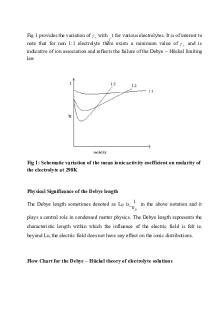
QB5 - Question Bank 5
- 104 Pages

Dmdw-question bank - question bank
- 17 Pages

Question bank
- 8 Pages

Question Bank 3question bank
- 6 Pages

Question BANK
- 19 Pages
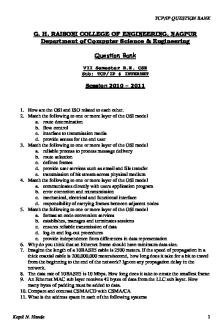
Tcp-ip-question-bank
- 25 Pages

Chapter 4 - Question Bank
- 28 Pages

DIP Question Bank Sheetal
- 14 Pages
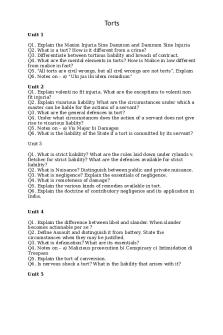
Torts Question Bank
- 2 Pages

Assessment Question Bank 1
- 22 Pages
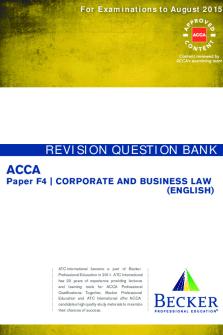
Revision Question Bank 60
- 154 Pages
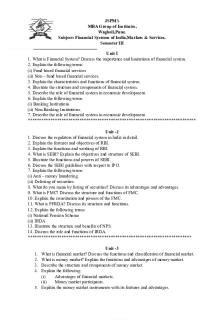
Fsims Question Bank
- 4 Pages

11. Autocad question bank
- 14 Pages
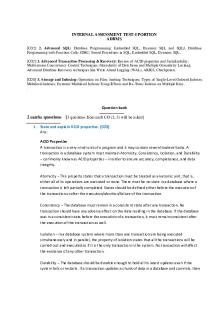
Question bank Adbms - solution
- 45 Pages

Viva Question Bank - CSS
- 17 Pages
Popular Institutions
- Tinajero National High School - Annex
- Politeknik Caltex Riau
- Yokohama City University
- SGT University
- University of Al-Qadisiyah
- Divine Word College of Vigan
- Techniek College Rotterdam
- Universidade de Santiago
- Universiti Teknologi MARA Cawangan Johor Kampus Pasir Gudang
- Poltekkes Kemenkes Yogyakarta
- Baguio City National High School
- Colegio san marcos
- preparatoria uno
- Centro de Bachillerato Tecnológico Industrial y de Servicios No. 107
- Dalian Maritime University
- Quang Trung Secondary School
- Colegio Tecnológico en Informática
- Corporación Regional de Educación Superior
- Grupo CEDVA
- Dar Al Uloom University
- Centro de Estudios Preuniversitarios de la Universidad Nacional de Ingeniería
- 上智大学
- Aakash International School, Nuna Majara
- San Felipe Neri Catholic School
- Kang Chiao International School - New Taipei City
- Misamis Occidental National High School
- Institución Educativa Escuela Normal Juan Ladrilleros
- Kolehiyo ng Pantukan
- Batanes State College
- Instituto Continental
- Sekolah Menengah Kejuruan Kesehatan Kaltara (Tarakan)
- Colegio de La Inmaculada Concepcion - Cebu
